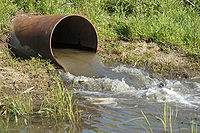
Photo from wikipedia
For advanced phosphorus and nitrogen removal, denitrifying phosphorus removal (DPR) was used to treat secondary effluent of sewage plants based on alternating anoxic/anaerobic process within single-stage biofilter. Under the hydraulic… Click to show full abstract
For advanced phosphorus and nitrogen removal, denitrifying phosphorus removal (DPR) was used to treat secondary effluent of sewage plants based on alternating anoxic/anaerobic process within single-stage biofilter. Under the hydraulic load of 3 m3/(m2·h), average removal rates of TP and TN in the system were 61.05% and 90.54%. 82.7% of the NO3--N removal occurred in the upper of the packing layer. TP removal occurred in upper and lower of the packing layer, accounting for 42.02% and 57.98% of the total removal, respectively. Biomass and bioactivity decreased proportional to the height incensement of packing layer. Nitrogen and phosphorus removal rates increased with anaerobic time while decreased with hydraulic load. 16S rDNA sequencing results showed dominant DNPAOs in the system included Acinetobacter and Dechloromonas, while dominant denitrifying bacteria included Flavobacterium, Comamonadaceae, Hydrogenophaga, Thauera and Azospira. The study further provided an effective and feasible way for advanced wastewater treatment.
Journal Title: Bioresource technology
Year Published: 2019
Link to full text (if available)
Share on Social Media: Sign Up to like & get
recommendations!